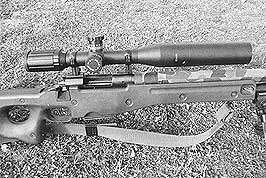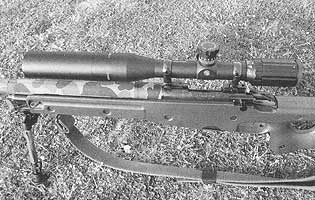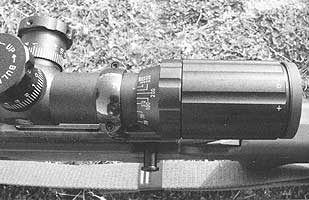The Lynx P16x42S Mildot Rifle Scope

The Lynx P16x42S fitted to the author's remington 700
It can be a rather daunting experience for the shooter wishing to begin competing in F-Class shooting. A casual look along the line of equipment being used will expose a number of large, complicated and expensive scopes with very high magnification.
These are far from ideal for the shooter starting out in scope shooting as they detract from learning the basic skills and they are not appropriate sighting systems for a large rifle.
If there were to be a list of key criteria for an entry level scope for F-Class shooting it would be:
-
High enough magnification to see the lines on the target back to 900 metres
-
High enough elevation adjustment for 300 – 900 metre (1000 yard) zeros
-
Easy to use elevation and windage adjustment
-
Clear optics; and
-
Rugged, lightweight but sturdy and aesthetically pleasing
While the first four points are self explanatory, the final point should not be scoffed at, as the scope needs not only to survive the rigours of the rifle range, including travel to and from competitions, it should also be something that the shooter is proud to own.The Lynx P16x42S is designed along tactical shooting lines. This is a style that is suited the requirements of the F-Class shooter as the high profile turrets provide easy access to make quick and precise adjustments. Elevation and windage adjustments have major divisions at one-minute intervals and minor divisions at ¼ minute intervals. These adjustments are designed to allow you to establish a zero, make adjustments on the range to suit conditions and then return to your original zero at the end of the shooting session.
The scope comes well packed in an attractive black box and includes detailed instructions on basic mounting and zeroing. Also included are bikini lens covers to keep dust and rain out, a lens cleaning cloth and an Allen key that can be used to zero the turrets to a known range. Lens shades, in two lengths to block mirage coming off the barrel, are available separately.The scope is fitted with a Mildot reticule. The Mildot reticule was originally designed for military shooters to accurately measure distance based on a mathematical equation related to the reticule measurement in the mils. The Mildot reticule is becoming increasingly popular for target shooters due to the flexibility offered. Not only by multiple aiming points, but also the ability to quickly calculate bullet deflection and accurately aim off during each shot.
At 16 power each Mildot covers 25mm at 100 metres, while the space between each Mildot covers 100mm. In effect, this means the Mildot will measure approximately 1 minute of Angle at each yardage shot in Australia.
The Lynx scope is 34 cm long and weighs in at 730 grams with mounts. The elevation, windage and side focus adjustment controls are knurled or ribbed for ease of adjustment. Lynx riflescopes are made in Japan to exacting specifications and are waterproof, shockproof and nitrogen filled to prevent fogging.Each of the lens’ surfaces in every Lynx scope is hard-coated with anti-reflective lens coating. Once the correct eye relief was established the image was bright and clear in a range of weather conditions.
The scope body is 30mm in diameter. Lynx scopes tubes are machined from aircraft grade aluminium and then anodised matte silver or black.
In the past Australian shooters have become used to one inch diameter tubes for their rifle scopes. While this is fine for hunting rifles, where the range of adjustment should not require much zeroing beyond 300 metres, a bigger diameter body not only allows more light into the scope and therefore a sharper image, it also allows for a greater range of elevation and windage adjustment. Fine focus is assisted with the addition of a parallax adjustment ring in front of the eyepiece.

It should be noted that an internal adjustment range of at least 35 minutes is required for a .308 Win with 155-grain bullets to reach from 100 to 1000 yards (911 metres) with no problems.
The internal elevation adjustment range offers over 90 minutes from top to bottom. This should offer enough range adjustment without the need for a tapered base. However, to get the greatest benefit from the scope it is worth having the scope bases angled for a minimum setting of at least a 300 metre zero. This has the benefit of putting the crosshairs closer to the centre of the image, providing less distortion and a clearer image at the longer ranges. Depending on the calibre chosen for target work and the ranges shot, the shooter should choose a base that has about a 20 MOA incline.
The elevation and windage knobs tracked accurately, however the knobs do not offer an audible feedback during adjustment. This is important for target shooters, as we need to have the confidence that a scope adjustment will move the bullet impact point when and where we want it to go. There are enough horror stories on the Ranges about scopes that need to be hit with a rubber mallet or worse to settle the internal adjustments.
Lynx rifle scopes are covered by a warranty against defects in materials of workmanship for 15 years.
The test scope was mounted on a Remington 700 action on an Accuracy International chassis stock, while the barrel was chambered in 6BR. This stock is perfect for all types of positional shooting and serves as a versatile platform for testing precision equipment.
The 600 metre Fullbore target was chosen as the best test for the scope as this is a challenging range to get a good score on. The Canberra Rifle Club range on a Saturday afternoon is also one of the trickier ranges to shoot well on and is an ideal venue to test equipment on.
During the range session, a rough windage zero was used for the prevailing condition and shot to shot adjustment was handled by aiming off. There are two schools of thought on how best to use a scope for long range target shooting; the other that the shooter should adjust from a known wind zero and add or subtract clicks from shot to shot while keeping the same point of aim. Each style has it’s merits and shooters must decide on what best meets their needs.
The rifle was shot from the prone position using a Versa-Pod adjustable bipod and a rear sand bag. The Accuracy International stock lends it’s self to position shooting and tracks well using this set-up.
The 6BR used a long-range target load of a 105 grain Lapua boat tail on 30 grains of AR2208 travelling at just over 290 fps with little recoil. Shooting heavy bullets across a variety of ranges had demonstrated the effectiveness of the 105 grain projectiles in a variety of conditions.
The Lapua 105-grain bullet has a ballistic coefficient of 0.53, which makes for a very slippery projectile. Groups with this load have ranged from three to five centimetres at three hundred metres.

A close up of the elevation, windage and focus adjustments
The first shot at 600m was a V bull. During this stage, the basics of marksmanship were followed with special emphasis on maintaining the sight picture, a consistent body position and stock weld. The smaller profile of the P16x42S allows the shooter to see changes to the wind flags without moving their head; something not always possible with the larger bodies scopes. The ten shots scored a 50.09.
This result backed up the findings of the 100 metre zero session that saw a three shot group measuring less than .25 inch emerge.The 16x is perhaps the lowest magnification to use and a 20x model is also available. Nevertheless, the Lynx P16x42S fulfills the criteria needed for a shooter starting out in the F-Class discipline. It is light, compact and simple enough to set up on a target rifle. The new shooter, or the shooter making the transition from Full Bore, would find a scope such as this a useful addition to their entry into F-Class.
